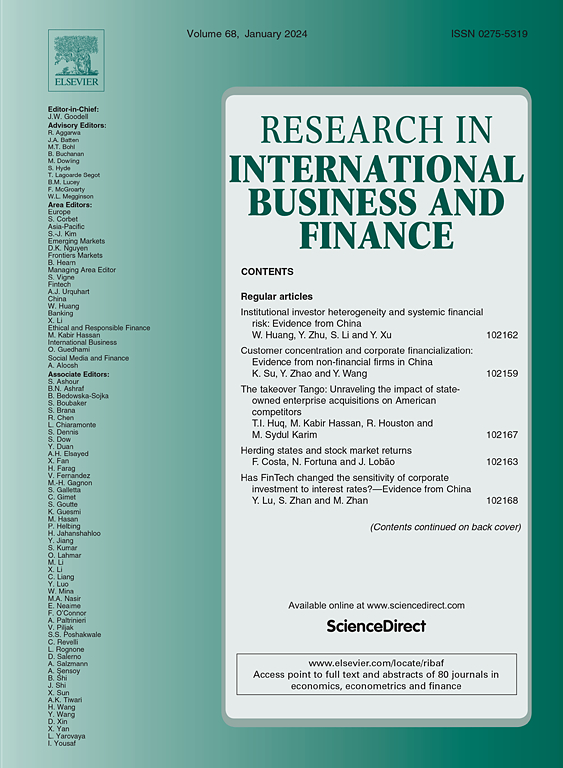股票市场分位数是否会干预商品期货和外汇市场收益中正负冲击的传导?
IF 6.9
2区 经济学
Q1 BUSINESS, FINANCE
Research in International Business and Finance
Pub Date : 2025-07-01
DOI:10.1016/j.ribaf.2025.103081
引用次数: 0
摘要
这是第一个研究商品期货(石油和黄金)和外汇市场回报在所有22个发达经济体股票回报的分位数中积极和消极创新的不对称影响的研究,同时考虑到不同的投资期限(短期和长期)。在方法上,我们将非线性自回归分布滞后(NARDL)模型与分位数回归相结合,从而利用基于分位数的NARDL (QNARDL)方法。此外,对于COVID-19子样本,我们通过纳入与大流行相关的新闻情绪等控制变量和分解美国非金融部门的正收益和负收益来增强QNARDL模型。总体而言,实证结果表明,股票市场对宏观经济和非宏观经济干扰的敏感性取决于四个关键维度:(1)现行股市制度(看涨、看跌或中性);(2)投资期限(短期vs长期);(3)来自外汇市场和商品期货的负面冲击和正面冲击的不对称传导机制;(4)时间分割(疫情前、疫情中和疫情后)。本文章由计算机程序翻译,如有差异,请以英文原文为准。
Do stock market quantiles intervene in the transmission of positive and negative shocks in the commodity futures and forex market returns?
This is first study to examine the asymmetric effects of positive and negative innovations in commodity futures (oil and gold) and foreign exchange market returns across the quantiles of stock returns of all of the 22 developed economies, while accounting for different investment horizons (short- and long-term). Methodologically, we used an integrated framework by combining the Nonlinear Autoregressive Distributed Lag (NARDL) model with quantile regression and thereby utilized the Quantile-based NARDL (QNARDL) approach. Further, for the COVID-19 subsample, we augmented the QNARDL model by incorporating control variables such as pandemic-related news sentiment and disaggregated positive and negative returns from the U.S. non-financial sector. Overall, the empirical results indicated that equity market sensitivities to macroeconomic and non-macroeconomic disturbances are conditional upon four critical dimensions: (1) prevailing stock market regimes (bullish, bearish, or neutral); (2) investment horizon (short- vs. long-term); (3) asymmetric transmission mechanisms of negative and positive shocks that originate from forex markets and commodity futures, and (4) temporal segmentation (pre-, during-, and post-COVID-19 periods).
求助全文
通过发布文献求助,成功后即可免费获取论文全文。
去求助
来源期刊

Research in International Business and Finance
BUSINESS, FINANCE-
CiteScore
11.20
自引率
9.20%
发文量
240
期刊介绍:
Research in International Business and Finance (RIBAF) seeks to consolidate its position as a premier scholarly vehicle of academic finance. The Journal publishes high quality, insightful, well-written papers that explore current and new issues in international finance. Papers that foster dialogue, innovation, and intellectual risk-taking in financial studies; as well as shed light on the interaction between finance and broader societal concerns are particularly appreciated. The Journal welcomes submissions that seek to expand the boundaries of academic finance and otherwise challenge the discipline. Papers studying finance using a variety of methodologies; as well as interdisciplinary studies will be considered for publication. Papers that examine topical issues using extensive international data sets are welcome. Single-country studies can also be considered for publication provided that they develop novel methodological and theoretical approaches or fall within the Journal''s priority themes. It is especially important that single-country studies communicate to the reader why the particular chosen country is especially relevant to the issue being investigated. [...] The scope of topics that are most interesting to RIBAF readers include the following: -Financial markets and institutions -Financial practices and sustainability -The impact of national culture on finance -The impact of formal and informal institutions on finance -Privatizations, public financing, and nonprofit issues in finance -Interdisciplinary financial studies -Finance and international development -International financial crises and regulation -Financialization studies -International financial integration and architecture -Behavioral aspects in finance -Consumer finance -Methodologies and conceptualization issues related to finance
 求助内容:
求助内容: 应助结果提醒方式:
应助结果提醒方式:


